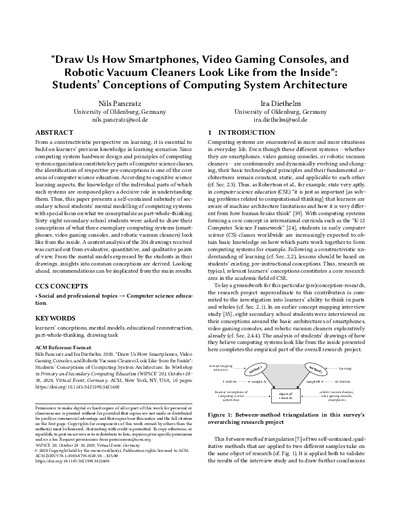"Draw us how smartphones, video gaming consoles, and robotic vacuum cleaners look like from the inside"students' conceptions of computing system architecture
Publikationsdatum:
Zu finden in: WiPSCE '20, 2020
|
 |
 Diese Seite wurde seit 2 Jahren inhaltlich nicht mehr aktualisiert.
Unter Umständen ist sie nicht mehr aktuell.
Diese Seite wurde seit 2 Jahren inhaltlich nicht mehr aktualisiert.
Unter Umständen ist sie nicht mehr aktuell.
 Zusammenfassungen
Zusammenfassungen


From a constructivistic perspective on learning, it is essential to build on learners' previous knowledge in learning scenarios. Since computing system hardware design and principles of computing system organization constitute key parts of computer science classes, the identification of respective pre-conceptions is one of the core areas of computer science education. According to cognitive science learning aspects, the knowledge of the individual parts of which such systems are composed plays a decisive role in understanding them. Thus, this paper presents a self-contained substudy of secondary school students' mental modelling of computing systems with special focus on what we conceptualize as part-whole-thinking. Sixty eight secondary school students were asked to draw their conceptions of what three exemplary computing systems (smartphones, video gaming consoles, and robotic vacuum cleaners) look like from the inside. A content analysis of the 204 drawings received was carried out from evaluative, quantitative, and qualitative points of view. From the mental models expressed by the students in their drawings, insights into common conceptions are derived. Looking ahead, recommendations can be implicated from the main results.
 Dieses Konferenz-Paper erwähnt ...
Dieses Konferenz-Paper erwähnt ...
 Dieses Konferenz-Paper erwähnt vermutlich nicht ...
Dieses Konferenz-Paper erwähnt vermutlich nicht ... 
 Nicht erwähnte Begriffe | Informatik, Informatik-Didaktik, Informatikunterricht in der Schule |
 Zitationsgraph
Zitationsgraph
 Zitationsgraph (Beta-Test mit vis.js)
Zitationsgraph (Beta-Test mit vis.js)
 Zeitleiste
Zeitleiste
 Anderswo finden
Anderswo finden
 Volltext dieses Dokuments
Volltext dieses Dokuments
 |  "Draw us how smartphones, video gaming consoles, and robotic vacuum cleaners look like from the inside": Fulltext at the ACM Digital Library ( "Draw us how smartphones, video gaming consoles, and robotic vacuum cleaners look like from the inside": Fulltext at the ACM Digital Library ( : :  , 1041 kByte; , 1041 kByte;  : :  ) ) |
 Anderswo suchen
Anderswo suchen 
 Beat und dieses Konferenz-Paper
Beat und dieses Konferenz-Paper
Beat hat Dieses Konferenz-Paper während seiner Zeit am Institut für Medien und Schule (IMS) ins Biblionetz aufgenommen. Beat besitzt kein physisches, aber ein digitales Exemplar. Eine digitale Version ist auf dem Internet verfügbar (s.o.). Aufgrund der wenigen Einträge im Biblionetz scheint er es nicht wirklich gelesen zu haben. Es gibt bisher auch nur wenige Objekte im Biblionetz, die dieses Werk zitieren.





















 Biblionetz-History
Biblionetz-History